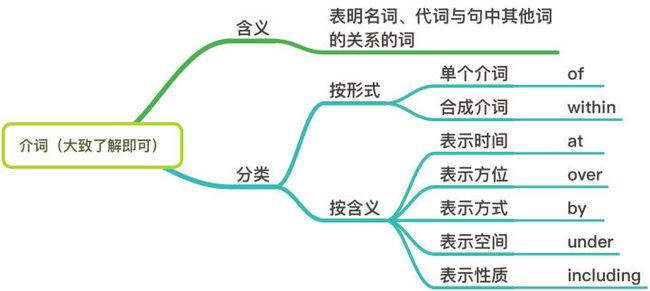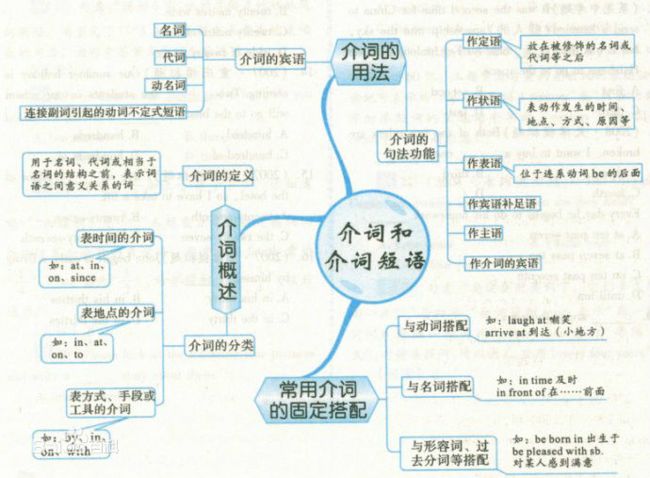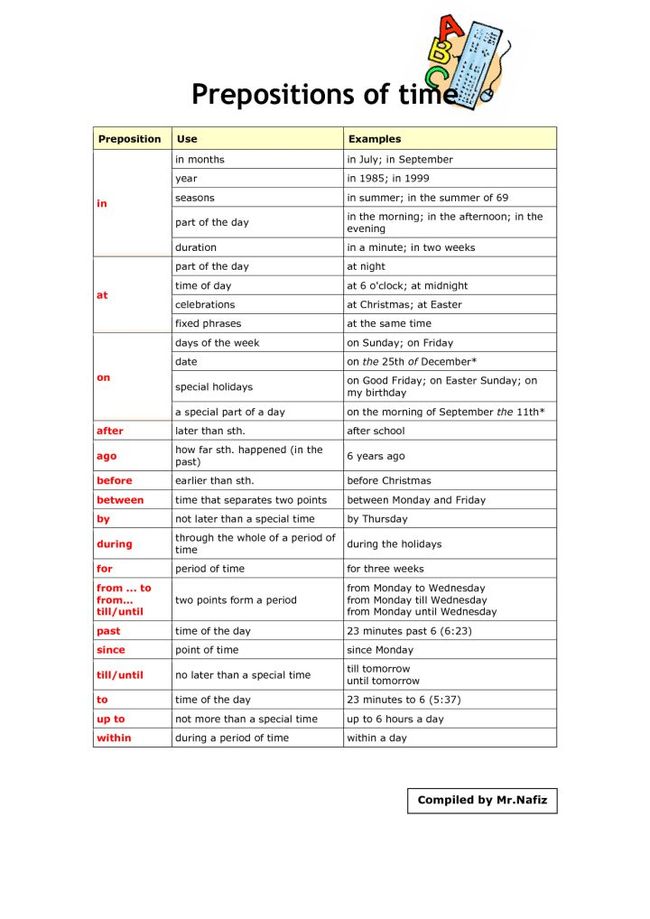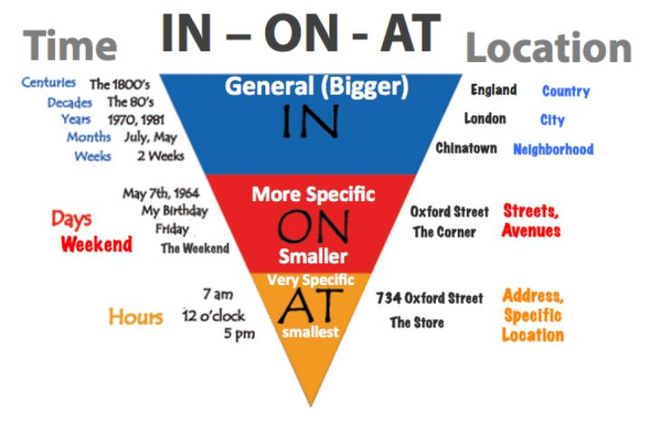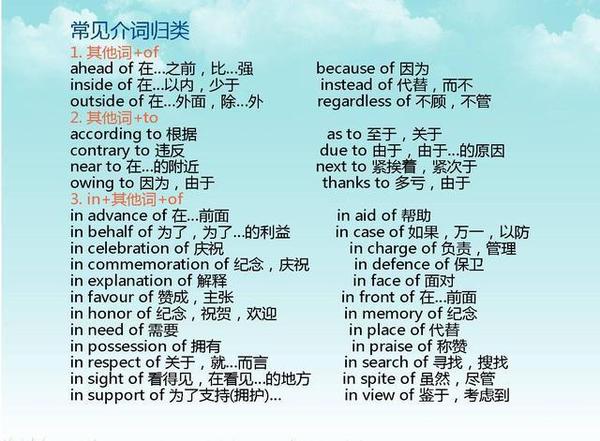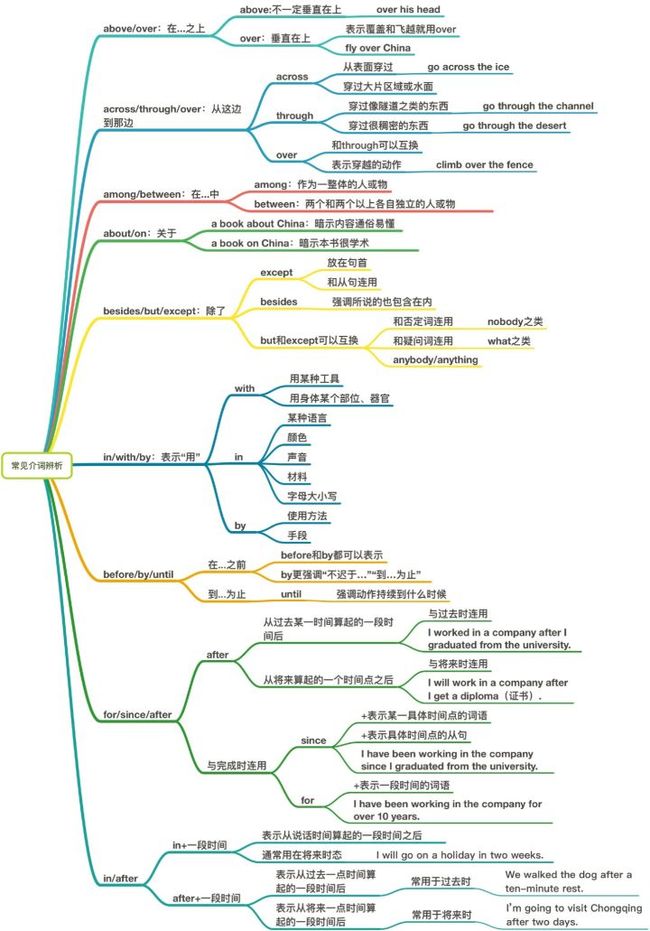由于中英文语言的差异,中国人对英语介词往往不容易掌握好应用。为了解决这个难题,感谢网友们整理编辑了图文并茂的说明,总结出本文,详细介绍什么时候该用什么介词,让英语学习者有了全面清晰的认识。功德无量。
介词(preposition 简写prep.),又称作前置词,表示名词、代词等与句中其它词的关系,在句中不能单独作句子成分。介词后面一般有名词、代词或相当于名词的其他词类、短语或从句作它的宾语,表示与其他成分的关系。
介词和它的宾语构成介词词组,在句中作状语,表语,补语,定语或介词宾语。同时介词的用法也很灵活,同一个介词可以表达多种意义,介词可以分为时间介词、地点介词、方式介词、原因介词、数量介词和其他介词。
介词一般用于名词或者代词前面,表示该词与句中其他成分的关系。介词后面的名词或代词称为介词宾语(如果是人称代词,则要用宾格)。介词和介词宾语合在一起构成介词短语。
简单介词
包括in,on,with,by,for,at,about,under,of,to等。(to为介词,意为“习惯(做)……”,后接名词,代词或动名词形式)
合成介词
包括into,within,throughout,inside,outside,without等
重叠介词
包括
from among 从...当中
from behind 从...后面,
until after 直至...之后,
at about 在大约...,
after about 在大约...之后 等
短语介词
一个或两个简单介词和一个或几个其他词类构成一个短语,作用相当于一个介词,这就叫做短语介词。这类介词的末尾总是一个简单介词。
如 according to,because of,by means of,in addition to,in front of, in spite of,into等。
分词介词
有极少数介词的词尾是“-ing”,形似现在分词(其中也有些可做分词)。
常用的有:considering,regarding,respecting,including。
按词义分
表示“地点(包括动向)”的有:about around(在...附近、周围),above(高于、在...斜上方),across(在...对面、横过)......
表示时间
1、表示在某时间.常用介词at,on,in等。
用 at 来表示在某一段时刻:
atdawn/daybreak: 在黎明
at six :在6点钟
atmidnight :在午夜
at 4:30 :在4点30分
用 at 来表示在……岁时
at sixteen/at the age of sixteen :16岁的时候
用 on 来表示在星期几/某日
on Monday :在星期一
on January fifth:在1月5日
on Christmas Day :在圣诞节那一天 也可用atChristmas
onNew Year's Day:在新年那天
用in来表示一天中的早中晚,月份,季节或年份
in the morning/afternoon/evening在早晨,下午,晚上
inJanuary/February在一月,二月
inSpring在春天
in 2014在2014年
2、表示 期间 常用介词during,for,over,within,throughout,from和to等。
during用于已知的一段时间包括大家熟知的节日或者某种已确切限定的时期或阶段之前
duringthe Middle Ages: 在中世纪
during1942 :在1942年中
duringthe summer(of that year):在(那一年的)夏季
duringhis childhood :在他童年时期
for用来表示一段时间
forsix years :六年之久
for two months :有两个月
forever :永远 [1]
3、表示其他时间概念的介词有before,after,since,until,till,between,up to等
表示方位
at ,in, on, to,
at (1)表示在小地方; (2)表示“在„„附近,旁边”
in (1)表示 在大地方; (2)表示“在„范围之内”。
on 表示毗邻,接壤,“在„„上面”。
to 表示在„„范围外,不强调是否接壤;或“到„„”
above, over, on 在„„上
above 指在„„上方,不强调是否垂直,与 below相对;
over指垂直的上方,与under相对,但over与物体有一定的空间,不直接接触。
on表示某物体上面并与之接触。
The bird is flying above my head.
There is a bridge over the river.
He put his watch on the desk.
below, under 在„„下面
under表示在„正下方
below表示在„„下,不一定在正下方
There is a cat under the table. Please write your name below the line.
in front [frant]of,in the front of在„„前面
in front of…意思是“在„„前面”,指甲物在乙物之前,两者互不包括;其反义词是behind(在„„的后面)。
There are some flowers in front of the house.(房子前面有些花卉。)
in the front of 意思是“在„..的前部”,即甲物在乙物的前部.反义词是at the back of…(在„„范围内的后部)。
There is a blackboard in the front of our classroom. 我们的教室前边有一块黑板。
Our teacher stands in the front of the classroom. 我们的老师站在教室前.(老师在教室里)
beside,behind beside 表示在„„旁边 behind 表示在„„后面
表示原因
表示原因常用的介词有for 等。
表示方法
表示“方法 ,手段”的介词常用by,with,through等
by bike : 骑自行车
表示数量
表示数量的常用介词有about(around),over等
与不及物动词搭配
不及物动词不能够直接跟宾语,且没有被动语态。但是和介词搭配后,不及物动词不但可以跟宾语,也有了被动语态。
常用介词短语
above构成的惯用短语:
above all 尤其是,最重要的是
above suspicion 无可怀疑
above praise 赞美不尽
above criticism 无可指责
above reproach 无可厚非
above price 价值连城
after构成的惯用短语
after all 毕竟,到底
day after day 日复一日
one after another 接二连三
page after page一页又一页地
year after year 年年岁岁
wave after wave一波又一波地
bus after bus 公共汽车一辆又一辆
at构成的惯用短语
at the sight of看到
at the news of听到
at one’s ease/ at one’s leisure 在闲暇时。
